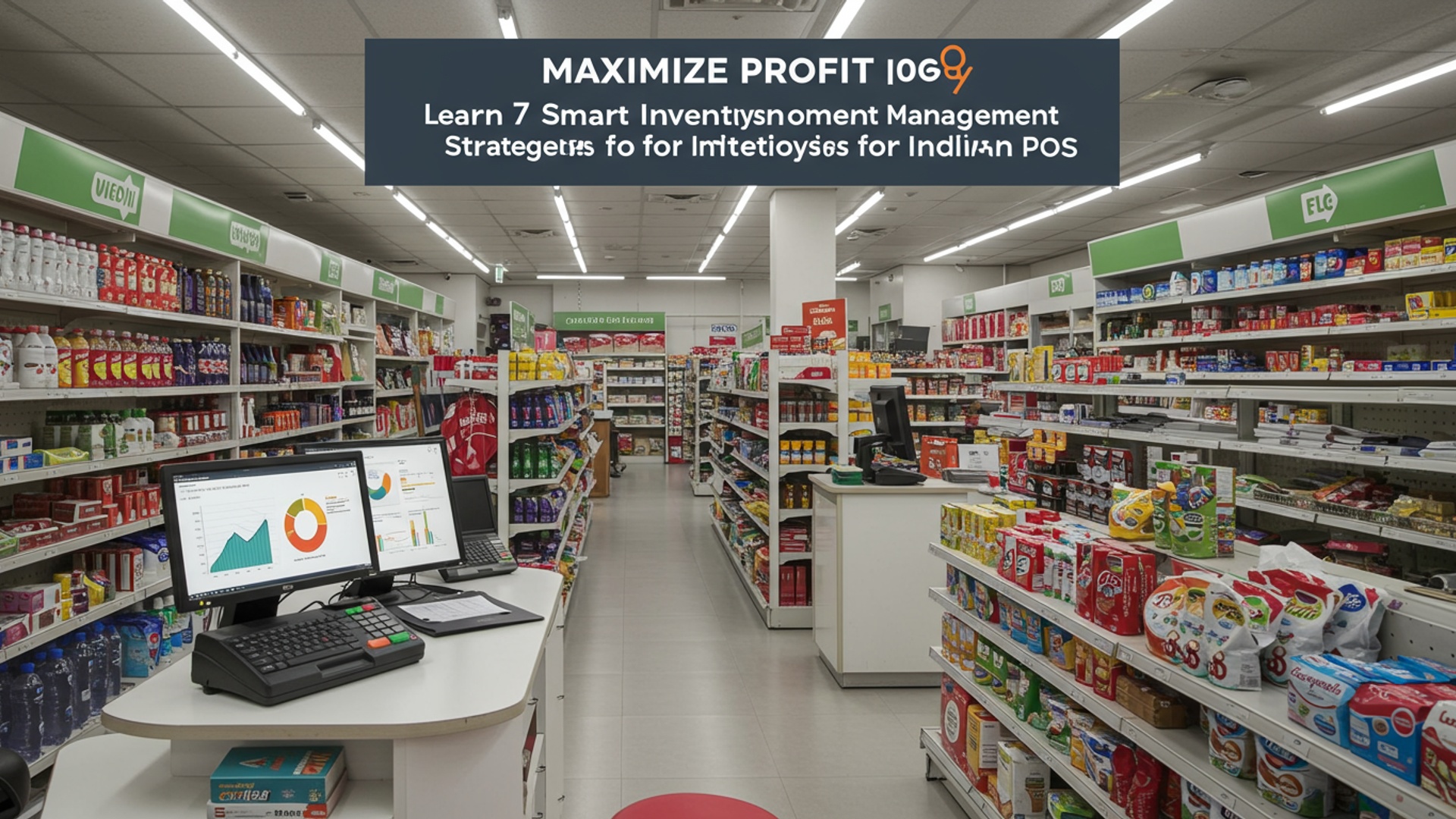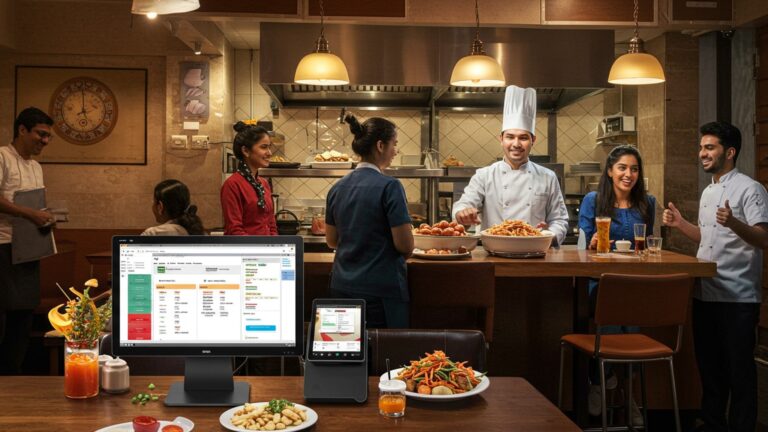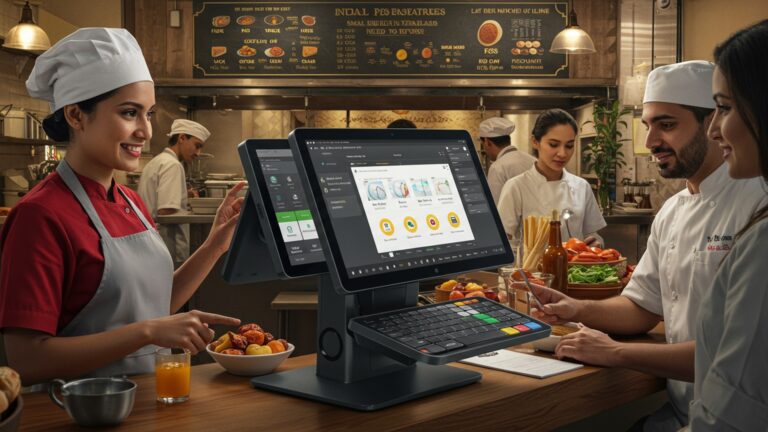Maximize Profit Learn 7 Smart Inventory Management Strategies for Indian POS
Indian retailers leveraging POS systems often grapple with a persistent profitability challenge: optimizing inventory amidst a rapidly evolving market. From managing seasonal surges for festive wear during Diwali to navigating sudden shifts in consumer preferences driven by aggressive e-commerce, inefficient inventory management in India directly erodes margins. Dead stock ties up vital working capital, while stockouts result in lost sales and diminished customer loyalty, especially with today’s omnichannel expectations. The complexities introduced by GST and the need for integrated supply chain visibility demand more than basic tracking; they necessitate sophisticated inventory strategies. Mastering smart inventory management within an Indian POS framework transforms operational costs into strategic capital deployment, unlocking substantial profit potential for your business.

The Crucial Role of Smart Inventory Management for Indian Businesses
In the dynamic and competitive landscape of Indian retail, managing inventory effectively isn’t just about counting stock; it’s a strategic imperative that directly impacts profitability, customer satisfaction. a business’s long-term sustainability. For businesses leveraging a Point-of-Sale (POS) system, optimizing inventory becomes even more critical. A robust inventory management POS India framework allows businesses, from bustling street-side stores to large departmental chains, to navigate supply chain complexities, meet consumer demands. significantly boost their bottom line. Before diving into the strategies, let’s briefly define what we mean by these core terms.
- Inventory Management
- Point-of-Sale (POS) System
This refers to the process of ordering, storing, using. selling a company’s inventory. This includes the management of raw materials, components. finished products, as well as warehousing and processing of such items. The goal is to minimize the cost of holding inventory while ensuring that products are available when customers want them.
A POS system is the hardware and software used to complete retail transactions. Beyond processing sales, modern POS systems integrate various functions like inventory tracking, customer relationship management (CRM), employee management. sales reporting, making them central to retail operations.
Effective inventory management, especially when integrated with an intelligent POS system, transforms operational challenges into opportunities for growth. It minimizes capital tied up in stock, reduces waste, prevents stockouts. ultimately enhances the customer experience. Let’s explore seven smart strategies designed to maximize profit for Indian businesses utilizing POS technology.
1. Embrace Real-Time Automated Tracking with Your POS
Gone are the days of manual ledger entries and periodic stock counts that often led to inaccuracies and delays. Modern POS systems offer sophisticated automated inventory tracking capabilities that are a game-changer for Indian businesses. Every sale, return, or stock adjustment is immediately recorded, providing an up-to-the-minute view of your inventory levels.
- How it Works
- Benefits for Indian Retailers
- Reduced Errors
- Improved Accuracy
- Enhanced Efficiency
- Immediate Insights
- Real-World Application
When a product is scanned at the checkout, the POS system automatically deducts that item from your inventory count. Similarly, when new stock arrives and is entered into the system, the inventory levels are updated instantly. Many systems also integrate barcode scanners and RFID technology for faster, more accurate data entry.
Eliminates human error associated with manual counting and data entry.
Provides a precise count of what’s on hand, preventing discrepancies.
Frees up staff from tedious manual tasks, allowing them to focus on customer service or other value-added activities.
Business owners can check stock levels from anywhere, at any time, via cloud-based POS solutions, making informed decisions on the go.
Consider “Sharma Kirana Store,” a local grocery in Delhi. Before integrating a POS, Mr. Sharma struggled with knowing exact stock levels, often leading to expired goods or missed sales due to stockouts. With a new POS, every pack of biscuits sold or fresh produce received is logged instantly. He can now see real-time stock levels on his mobile, allowing him to reorder precisely what’s needed, significantly cutting down wastage and improving product availability. This level of effective inventory management POS India is no longer a luxury but a fundamental requirement for competitive advantage.
2. Leverage Data for Smart Demand Forecasting and Predictive Analytics
One of the most powerful features of a modern POS system is its ability to collect and assess vast amounts of sales data. This data is a goldmine for demand forecasting, allowing businesses to predict future sales trends with remarkable accuracy. By understanding what customers will want. when, you can optimize your inventory levels, preventing both overstocking and understocking.
- Key Data Points to review
- Historical Sales Data
- Seasonal Trends
- Promotional Impact
- External Factors
- How POS Aids Forecasting
- Benefits
- Optimized Working Capital
- Reduced Carrying Costs
- Minimized Stockouts
- Enhanced Customer Satisfaction
- Actionable Takeaway
Past sales figures reveal recurring patterns, seasonal spikes. steady demand for certain products.
Festivals like Diwali, Eid, Christmas, or specific weather patterns (e. g. , demand for umbrellas during monsoon) significantly impact sales.
examine how past discounts or marketing campaigns affected sales volume.
Economic indicators, competitor activities. even local events can influence demand.
Your POS system records every transaction, product category, time of sale. even customer data. Advanced POS solutions come with built-in analytics dashboards or can integrate with business intelligence tools to process this data.
Avoid tying up cash in slow-moving or excess inventory.
Lower expenses related to storage, insurance. potential obsolescence.
Ensure popular items are always available, preventing lost sales and customer frustration.
Customers appreciate finding what they need, when they need it.
Regularly review your POS sales reports. Look for patterns. If you’re a clothing retailer in Mumbai, examine sales data from previous festive seasons (e. g. , Ganesh Chaturthi or Navratri) to predict demand for ethnic wear. Use this data to place smarter orders with your suppliers well in advance.
3. Optimize Supplier Relationships and Adopt Just-In-Time (JIT) Principles
Your suppliers are an extension of your inventory management strategy. Building strong relationships and negotiating favorable terms can significantly impact your stock levels and cash flow. Moreover, adopting Just-In-Time (JIT) inventory principles, where goods are ordered and received only as they are needed, can drastically reduce carrying costs.
- Supplier Relationship Management (SRM)
- Negotiate Terms
- Reliability
- Communication
- Just-In-Time (JIT) Inventory
- Definition
- Indian Context
- How POS Helps
- Comparison: JIT vs. Traditional Stocking
- Case Study
Discuss payment terms, delivery schedules. minimum order quantities. A good relationship can lead to more flexible terms.
Partner with suppliers known for consistent quality and on-time delivery. Your POS data can highlight which products sell fastest, helping you prioritize reliable suppliers for these key items.
Maintain open lines of communication. Inform suppliers of upcoming promotions or anticipated demand spikes so they can prepare.
JIT is a strategy that aims to minimize inventory and increase efficiency by receiving goods only as they are needed in the production process or for sale.
While challenging in a country with diverse logistics, JIT can be effectively applied to high-turnover items or those with predictable demand. For instance, a bakery might receive fresh ingredients daily, aligning with JIT.
Your POS system’s real-time sales data and forecasting capabilities are crucial for successful JIT. It tells you exactly what to order and when, minimizing the risk of running out of stock.
| Feature | Just-In-Time (JIT) | Traditional Stocking |
|---|---|---|
| Inventory Levels | Minimal, only what’s needed for immediate demand | High, buffer stock for potential demand surges |
| Carrying Costs | Very Low (reduced storage, insurance, obsolescence) | High (significant capital tied up, storage costs) |
| Risk of Obsolescence | Low (frequent turnover) | High (older stock may become outdated) |
| Supplier Dependence | High (requires reliable, flexible suppliers) | Moderate (more forgiving of supplier delays) |
| Cash Flow Impact | Positive (less capital tied in inventory) | Negative (more capital tied in inventory) |
A popular electronics store in Bengaluru, “TechHub,” struggled with holding large inventories of new smartphone models that quickly became obsolete. By adopting JIT principles for fast-moving models, facilitated by their advanced inventory management POS India system’s sales analytics, they now place smaller, more frequent orders from their distributors. This has drastically reduced their holding costs and minimized losses from unsold, outdated models.
4. Implement SKU Rationalization and ABC Analysis
Not all products are created equal in terms of their contribution to your profit. SKU rationalization and ABC analysis are powerful techniques to categorize your inventory, allowing you to focus your efforts and resources where they will have the most impact.
- SKU Rationalization
- Definition
- How POS Helps
- Actionable Steps
- ABC Analysis
- Definition
- A-Items (High Value)
- B-Items (Medium Value)
- C-Items (Low Value)
- How POS Helps
- Management Strategy by Class
- A-Items
- B-Items
- C-Items
- Example
This involves identifying and eliminating slow-moving, obsolete, or unprofitable Stock Keeping Units (SKUs) from your inventory.
Your POS system provides detailed sales reports for each SKU. Identify items with low sales velocity, high holding costs, or those that haven’t sold in a specific period.
Consider clearance sales, bundles with faster-moving items, or returning them to suppliers (if possible) to clear out dead stock and free up valuable shelf space and capital.
This method categorizes inventory items into three classes based on their value or importance to the business.
Typically 10-20% of SKUs. account for 70-80% of sales value. These are your most crucial items.
Roughly 30% of SKUs, contributing 15-25% of sales value.
Around 50-60% of SKUs. only 5-10% of sales value. These are numerous but individually less critical.
Your POS system’s sales data is essential for performing ABC analysis. Export sales data, categorize items by revenue generated. then group them into A, B. C classes.
Require tight control, frequent review, accurate forecasting. often JIT principles. Ensure these are never out of stock.
Moderate control, regular reviews. standard ordering policies.
Simpler control, perhaps bulk ordering. less frequent reviews. While low value individually, collectively they can add up.
A general merchandise store in Chennai uses their POS data to identify that their “A-items” include popular brands of packaged snacks and beverages, while “C-items” might be specific stationary products. They ensure their A-items are always well-stocked and frequently replenished, sometimes even hourly during peak times, whereas C-items are ordered in larger quantities less frequently. This targeted approach in inventory management POS India optimizes their stock levels and reduces capital expenditure on less profitable items.
5. Synchronize Inventory Across All Sales Channels
For many Indian businesses today, sales aren’t confined to a single physical store. E-commerce platforms, social media selling. multiple physical outlets mean customers can interact with your brand across various channels. A critical strategy for maximizing profit is ensuring your inventory is perfectly synchronized across all these channels.
- The Omnichannel Challenge
- Stockouts
- Dead Stock
- Inaccurate details
- The Solution: Centralized Inventory Management
- This involves a single, unified database that tracks all inventory, regardless of where it’s stored or sold.
- Modern POS systems are often designed to integrate with e-commerce platforms (like Shopify, WooCommerce, or even custom Indian platforms) and other store locations.
- When a sale occurs on any channel (online or in-store), the central inventory is updated in real-time.
- Benefits
- Prevent Stockouts and Overselling
- Optimize Fulfillment
- Improved Customer Experience
- Reduced Holding Costs
- Example
A customer orders an item online only to find it’s out of stock at the warehouse, even if it’s available in a physical store.
An item might be sitting unsold in one store while another store (or the online channel) has high demand for it.
Different stock levels showing on different platforms lead to customer frustration and operational headaches.
Accurately reflects available stock across all channels, avoiding disappointing customers.
Allows for flexible fulfillment options, such as “buy online, pick up in store” (BOPIS) or shipping from the nearest store location.
Consistent and accurate product availability insights builds trust.
By having a holistic view, you can easily transfer stock between stores or channels to meet demand, reducing overall excess inventory.
“FabFashions,” an apparel chain with five stores across Mumbai and a growing online presence, used to struggle with inventory discrepancies. Their old system showed an item as “available” online. it was often sold out in the warehouse. After implementing a cloud-based POS that seamlessly integrated with their e-commerce platform, they achieved real-time synchronization. Now, if a customer buys a dress online, the system checks all store inventories and the warehouse, updates stock. even suggests the nearest store for pickup if that’s the customer’s preference. For modern retailers, seamless inventory management POS India across channels is paramount.
6. Implement Robust Loss Prevention and Shrinkage Control
Shrinkage, which refers to the loss of inventory due to factors other than sales, is a silent killer of profits. It includes theft (employee or customer), administrative errors, damage. spoilage. Proactive loss prevention strategies are crucial for maximizing profitability.
- Common Causes of Shrinkage in India
- Employee Theft
- Customer Theft (Shoplifting)
- Administrative Errors
- Damage/Breakage
- Spoilage/Expiration
- Strategies for Control
- Leverage POS Data
- Access Control
- Security Measures
- Staff Training
- Regular Audits (see next point)
- Supplier Verification
- Proper Storage
- Example
Pilferage, “sweethearting” (undercutting prices for friends), or outright stealing.
Especially in stores with high foot traffic or open displays.
Incorrect receiving, miscounts during stock takes, data entry mistakes, or wrong pricing.
Due to poor handling, storage, or transit.
Particularly relevant for food, pharmaceuticals. perishable goods.
assess sales vs. inventory reports regularly. High discrepancies can flag potential theft or errors. The POS can also track voids, returns. discounts, highlighting suspicious patterns.
Restrict access to inventory storage areas.
Install CCTV cameras, anti-theft tags (EAS). security personnel, especially for high-value items.
Train employees on proper inventory handling, POS operation. loss prevention protocols. Foster a culture of honesty and accountability.
Frequent checks help identify issues early.
Double-check incoming shipments against purchase orders to catch discrepancies.
Ensure goods are stored correctly to prevent damage and spoilage, especially for temperature-sensitive items.
A large supermarket chain in Hyderabad identified significant losses from perishable goods like dairy and fresh produce. By implementing stricter receiving protocols (using their POS to scan and verify every incoming item), regular shelf-life checks. better staff training on rotation (FIFO – First-In, First-Out), they significantly reduced spoilage. Their POS system also helped them track inventory movement within the store, identifying areas prone to damage or misplaced items.
7. Conduct Regular Inventory Audits and Cycle Counting
Even with automated systems, periodic verification is essential to ensure that your physical inventory matches your system records. This is where inventory audits and cycle counting come into play. These practices are critical for maintaining data accuracy and identifying discrepancies early.
- Full Inventory Audit
- Definition
- Frequency
- Purpose
- How POS Helps
- Cycle Counting
- Definition
- Frequency
- Benefits
- Less Disruptive
- Higher Accuracy
- Early Detection
- Improved Data Reliability
- Reduced Need for Full Audits
- How POS Helps
- Actionable Takeaway
A comprehensive physical count of all inventory items at a specific point in time.
Typically once or twice a year, often requiring a temporary store closure or operations halt.
To get a complete snapshot of inventory, reconcile major discrepancies. serve as a baseline for future cycle counts.
Your POS system provides the digital record to compare against the physical count, making the reconciliation process much more efficient.
An ongoing process of counting a small, specific portion of inventory on a regular, rotating basis, rather than counting everything at once.
Daily, weekly, or monthly, depending on the item’s importance and turnover rate.
Doesn’t require closing the store.
Smaller counts are easier to manage and less prone to error.
Discrepancies are found and corrected quickly, preventing them from escalating.
Constantly refines the accuracy of your POS inventory records.
If cycle counting is effective, full audits can be less frequent or even eliminated.
Modern POS systems can generate cycle count lists based on various criteria (e. g. , high-value items, fast-moving items, or items with recent discrepancies). Staff can use handheld scanners integrated with the POS to update counts directly, streamlining the process.
Develop a cycle counting schedule. For “A-items” (from your ABC analysis), count them weekly. “B-items” might be monthly. “C-items” quarterly. Use your inventory management POS India reports to highlight items with the highest discrepancy rates for more frequent counting.
Conclusion
Navigating the dynamic landscape of Indian retail demands more than just selling; it requires astute inventory management to truly maximize your profit margins. From my observations, businesses often underestimate the hidden costs of both overstocking and understocking, directly impacting cash flow and customer loyalty. Embracing the 7 smart strategies discussed isn’t merely about cutting losses; it’s about transforming your operational efficiency, ensuring your shelves are stocked with what customers genuinely want, precisely when they want it. To truly capitalize on these insights, take action today by leveraging robust POS solutions that provide real-time data. This proactive, data-driven approach, as explored in articles like Mastering Cloud Based POS Software: How to Boost Your Business Efficiency, empowers you to make informed decisions, whether it’s optimizing reorder points or identifying slow-moving items like outdated festive wear before they become dead stock. Start small, perhaps by implementing cycle counting or refining your vendor relationships. build momentum. Your journey to sustained profitability begins with discipline and smart application of these strategies. Don’t just manage inventory; master it to unlock unparalleled growth and ensure your Indian POS business thrives in this competitive market. The power to transform your bottom line is now in your hands.
More Articles
How to Select the Perfect POS Software for Your Retail Business Needs
5 Essential Strategies to Master Clothing Inventory Management Systems
How to Choose the Best POS Software to Streamline Your Sales
How to Implement POS Software for Your Grocery Store: A Complete Guide
7 Essential Features Your Apparel Store Billing Software Needs to Succeed
FAQs
What’s this whole ‘7 Smart Inventory Management Strategies’ thing about?
This guide is all about helping Indian Point of Sale (POS) businesses boost their profits by getting really good at managing their inventory. It breaks down seven practical, smart ways to handle your stock more efficiently, reducing waste and ensuring you always have what customers want.
Who exactly should read this guide?
If you run a retail store, a restaurant, or any business in India that uses a POS system and deals with physical stock – big or small – this guide is for you. It’s particularly useful for owners and managers looking to cut costs and increase earnings through better stock control.
Why should I even bother with better inventory management? Doesn’t my current system work fine?
Good question! While your current system might ‘work,’ smart inventory management can significantly impact your bottom line. It helps you avoid stockouts (losing sales), overstocking (tying up cash and risking spoilage/obsolescence). reduces theft. Ultimately, it means more cash in your pocket and happier customers.
What kinds of strategies will I learn in this guide?
You’ll dive into practical methods like accurate demand forecasting to predict what sells, using ABC analysis to prioritize your most valuable items, optimizing reorder points, leveraging vendor relationships. implementing technology for real-time tracking. It’s all about making your inventory work smarter for you.
How are these strategies specifically relevant for Indian businesses?
The guide considers the unique challenges and opportunities of the Indian market, such as varying supply chain complexities, local consumer behavior. the need for cost-effective solutions. While the core principles are universal, the application is tailored to the Indian POS environment.
Will implementing these strategies be a huge, complicated task?
The guide aims to present these strategies in an understandable and actionable way. While any change requires effort, the focus is on practical steps you can take. Some strategies might be easier to implement than others. they are designed to be broken down into manageable actions that yield tangible results over time.
Can these strategies actually help me make more profit?
Absolutely! That’s the main goal. By minimizing waste, preventing lost sales due to stockouts, reducing carrying costs of excess inventory. improving cash flow, these strategies directly contribute to increasing your profit margins and overall business efficiency.





